
Tässä on puistokäytävän viereen aurattua lumivallia Espoon Tapiolassa. Lumen seassa oli sen vuoksi likaisia kohtia käytävän hiekasta johtuen. Kuvaushetkellä lämpötila oli aavistuksen plussan puolella, mutta siitä huolimatta lumi ei ollut suojalunta; kuiva Föhntilanne. Tässä lumessa likaiset kohdat olivat kuitenkin sulamassa auringon säteilyn vaikutuksesta, koska tummina ne imivät enemmän ko. säteilyn lämpöä itseensä kuin valkoisemmat kohdat. Tummien kohtien albedo oli siis pieni ja eri lumen osat sulivat siten eri tahtiin auringon paistaessa. Tämä lumihangen ilmiö on suurimmillaan maaliskuussa pakkasella, kun aurinko paistaa jo keväisen voimakkaasti. Säätilanne: valitse 28.1.2006; Wetter3 A. Wetter3 B.
Here is a embankment of plowed snow beside a path in a park in the district of Tapiola in Espoo. Therefore there was dirty spots among the snow due to a sand of the path. At the time of the photoshoot the temperature was very little above zero C, but the snow wasn't at thaw stage despite of that; a dry Föhn situation. However here in the snow the dirty spots were melting due to the radiation of the sun, because they were absorbing more heat into themselves from that radiation than whiter parts. Albedo of the dark spots was therefore small and different parts of the snow were therefore melting in different rates when the sun was shining. This phenomenon of the snowcover is greatest during March in frosty weather, when the sun shines like in spring (allthough weather is still wintry). Weather condition: choose 28.1.2006; Wetter3 A. Wetter3 B.Helsingin Puistolan säätilasto tammikuussa 2006 - Weather chart of Puistola, Helsinki in January 2006.Flickr 1 Flickr 2 
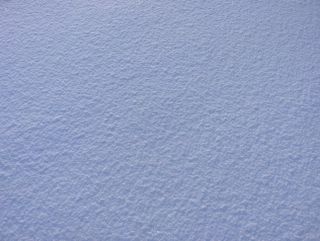
Tässä nähdään tasaista lumen pintaa, jossa oli hyvin näkyvissä yksittäiset lumihiutaleet vasta sataneesta lumesta. Pinnalla oli myös ilman kosteuden kuuraa. Ne säilyivät ja kehittyivät kuvaushetkeen näin hyvin, koska satamishetkellä ja se jälkeen oli riittävän heikkotuulista. Kuvaushetkellä lämpötila oli kohonnut nollan tienoille ja aavistuksen suojankin puolelle, mutta johtuen kylmästä maasta ja kuivasta ilmasta lumi ei ollut vielä suojalunta. Hanki oli kuitenkin tiivistynyt hieman kovemmaksi useiden päivien kuluessa. Kuva on otettu Espoon Tapiolassa kohti harsopilvien läpi paistanutta auringonvaloa; siitä sinisyys eli toisin sanoen kohta sai runsaasti osittain sinisen taivaan hajavaloa. Säätilanne: valitse 28.1.2006; Wetter3 A. Wetter3 B.
In here we see smooth surface of the snowcover, where there were finely visible separate snowflakes of the fresh fallen snow. On the surface there was also a frost of the air moisture. They remained and progressed so well until the time of the photoshoot, because during the snowfall and after that winds were still enough. At the time of the photoshoot the temperature had been risen to around zero C and even a hint above it, but due to coldness of the ground and drieness of the air the snow wasn't at thaw stage yet. However the crust of snow had been compressed a little stiffer during several earlier days. The picture is taken in the district of Tapiola in Espoo towards the sunlight that was coming through cirrostratus clouds; therefore the blue tone and in other words the spot reseaved a plenty of dispersed light of the partly blue sky. Weather condition: choose 28.1.2006; Wetter3 A. Wetter3 B.Helsingin Puistolan säätilasto tammikuussa 2006 - Weather chart of Puistola, Helsinki in January 2006.Flickr 1 Flickr 2 
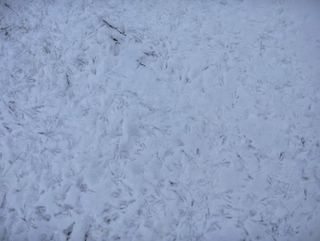
Kuvassa nähdään runsaasti lintujen jälkiä. Kuva on otettu Vantaan Tikkurilassa eräässä puistossa. Aikaisemmin vallinnut kova pakkanen oli vaihtunut kuvan tilanteessa paljon leudommaksi sääksi; lämpötila oli nyt nollan vaiheilla koko päivän edellisen päivän lounaistuulen ansiosta. Kuvauskohdan lähellä on puita ja pensaita, joissa nämä linnut (harakat) viihtyivät isoissa parvissa sään lauhduttua ja niinpä lumi sai olla tallentamassa luonnon merkkejä itseensä. Säätilanne: valitse 25.1.2006; Wetter3 A. Wetter3 B.
In the picture we see plenty of tracks made by birds. The photo is taken in the district of Tikkurila in Vantaa (near Helsinki) in some park. The previous severe frost had been turned into much milder weather in the situation of the picture; the temperature was now around zero C all day due to the southwesterly wind of the previous day. Nearby the shooting spot of the picture there are trees and shrubs, where these birds (magpies) were in big flocks since the weather got milder and therefore the snow had a place for capturing signs of nature onto itself. Weater condition: choose 25.1.2006; Wetter3 A. Wetter3 B.Helsingin Puistolan säätilasto tammikuussa 2006 - Weather chart of Puistola, Helsinki in January 2006.Flickr 1 Flickr 2 

Edellisen kuvan kanssa samana päivänä ja samassa paikassa otetussa kuvassa nähdään pöllynneen pakkaslumen pyyhkiytyneen pois tasaisen liukkaalta jääpinnalta. Sen ympärillä oli joko paljasta nurmikkoa tai rosoista vanhan lumen jäistä jäännettä, jolloin tämä uusi lumi jäi niille pinnoille paremmin kovassakin tuulessa. Tuulensuunta oli kuvassa suoraan edestä päin kohti kuvaajaa. Kuvaushetkellä tuulet olivat jo heikentyneet ja lämpötilat olivat -21,8 ja -17,9 asteen välillä. Vähäisen lumen vuoksi routa eteni nyt nopeasti. Säätilanne: valitse 19.1.2006; Wetter3 A. Wetter3 B.
As pictured in the same day and in the same location as the previous photo we see in this picture the whirled up dry frosty snow wiped away from the smoothly slippery ice surface. Around it there were either naked grass or rough remains of the old icy snow and therefore this new snow settled on these surfaces better even during hard winds. The direction of the wind was straight from ahead towards the photographer. At the time of the photoshoot winds had been eased allready and the temperatures were between -21,8 C and -17,9 C. Due to the little amount of snow the soil frost advanced now fast. Weather condition: choose 19.1.2006; Wetter3 A. Wetter3 B.Helsingin Puistolan säätilasto tammikuussa 2006 - Weather chart of Puistola, Helsinki in January 2006.Flickr 1 Flickr 2 
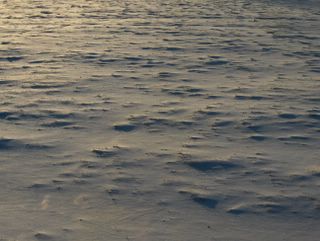
Kahden edellisen päivän aikana tapahtui voimakas kylmeneminen kovan tuulen myötä. Samalla satoi jonkin verren kuivaa pakkaslunta, joka pöllysi tuulen mukana. Kuvassa nähdään hyvä esimerkki siitä, kuinka tällainen lumi muodostaa pieniä dyynimäisiä muotoja nurmikon korsien ym. epätasaisille kohdille. Tilanteessa vallinnut tuulensuunta näkyi muodoista hyvin; se oli kuvassa vasemmalta oikealle eli kaakosta - idästä. Kuva on otettu Espoon Tapiolassa. Säätilanne: valitse 19.1.2006; Wetter3 A. Wetter3 B.
During the previous two days the temperature got much colder with a hard wind. At the same time it snowed a little of dry frosty snow, which whirled about with the wind. In the picture we see a good example of how this kind of snow forms small dynelike shapes amongst the blades of grass and around other uneven spots. The direction of the wind during the situation was told well from the shapes; in the picture it was from the left to the right in other words from the southeast - east. The picture is taken in the district of Tapiola in Espoo (near Helsinki). Weather condition: choose 19.1.2006; Wetter3 A. Wetter3 B.Helsingin Puistolan säätilasto tammikuussa 2006 - Weather chart of Puistola, Helsinki in January 2006.Flickr 1 Flickr 2 

Tämä kuva on otettu samana päivänä ja samassa paikassa kuin edellinen kuva. Kuvassa nähdään jälleen pöllynneen pakkaslumen paljastaneen kiinnostavia kuvioita. Tässä tapauksessa nurmikon päällä oli vanhan lumipeitteen jäisiä rippeitä, missä ihmisten jalanjälkien vuoksi jään pinta oli vaihtelevasti muhkuraista. Niinpä tilanne oli otollinen lumen taiteelle pöllyvävän pakkaslumen ansiosta. Säätilanne: valitse 18.1.2006; Wetter3 A. Wetter3 B.
This picture is taken in the same day and in the same location as the previous photo. In the picture we see once more an interesting set of figures as revealed by the whirled up dry frosty snow. In this case icy remains of the old snow were on top of a lawn, where the footprints of people caused the surface of the ice to be bumpy. Therefore the situation was suitable for the art of snow thanks to the whirling up dry frosty snow. Weather condition: choose 18.1.2006; Wetter3 A. Wetter3 B.Helsingin Puistolan säätilasto tammikuussa 2006 - Weather chart of Puistola, Helsinki in January 2006.Flickr 1 Flickr 2 

Tämän jään pinta oli erikoisesti pieniksi osiksi lohkeillutta. Kyseessä oli nurmikolla ollut melko syvä (yli 10 cm) lätäkkö ja se jäätyi aluksi hitaasti pinnalta heikossa pakkasessa 15. tammikuuta tienoilla. Sitten 17. ja 18. tammikuuta nopeasti kiristyneen pakkasen myötä jäätyminen tapahtui selvästi eri nopeudella loppuun asti. Ilmeisesti nopeamman jäätymisprosessin yhdistyminen aikaisemmin jäätyneeseen ohueen ja vetiseen jäähän ja kylmenemisen yhteydessä pöllynnyt lumi siihen sekaan aiheuttivat jään pinnan "elämisen". Sitten siihen päälle edelleen pöllyttämällä satanut pakkaslumi paljasti rakenteen piirteet. Kuva on otettu Vantaan Tikkurilassa eräässä puistossa. Säätilanne: valitse 18.1.2006; Wetter3 A. Wetter3 B.
The surface of this ice was peculiarly fractured into small parts. It was a rather deep (more than 10cm) puddle situated on a lawn and it froze slowly at first on the surface around the 15th of January. Then during the 17th and the 18th of January due to rapid drop of temperature the freezing happened in a completely different rate to the end. Obviously the union of the fast freez with the earlier thin and wet ice and the drop of the temperature related whirled up snow amongst there caused the surface of the ice to "live". Then on the top of that dry frosty snow whirled up further with a strong wind revealing the figures of the structure. The picture is taken in the district of Tikkurila in Vantaa in some park. Weather condition: choose 18.1.2006; Wetter3 A. Wetter3 B.Helsingin Puistolan säätilasto tammikuussa 2006 - Weather chart of Puistola, Helsinki in January 2006.Flickr 1 Flickr 2 
 Tämä kuva täydentää kahden alemman kuvan kanssa samassa paikassa ja tilanteessa kuvatun pakkaslumen tuiskuamissarjan. Tässä oli puistokäytävälle muodostunutta jäätä, jonka päälle tämä uusi lumi oli pöllyämässä. Lumi tarttui kauniisti jään karheisiin kohtiin (mm. hiekan jyviä) ja näin muodostui luonnon omia lumimaalauksia. Säätilanne: valitse 17.1.2006; Wetter3 A. Wetter3 B.This picture sums up with the two previous pictures the whirl up series of the dry frosty snow pictured in the same location and situation. Here on the path of the park there was ice and on the top of that this new snow was whirling about. The snow grabbed beautifully into the rough parts (like particles of sand) of the ice and so nature's own paintings of the snow were formed. Weather condition: choose 17.1.2006; Wetter3 A. Wetter3 B.Helsingin Puistolan säätilasto tammikuussa 2006 - Weather chart of Puistola, Helsinki in January 2006.Flickr 1 Flickr 2
Tämä kuva täydentää kahden alemman kuvan kanssa samassa paikassa ja tilanteessa kuvatun pakkaslumen tuiskuamissarjan. Tässä oli puistokäytävälle muodostunutta jäätä, jonka päälle tämä uusi lumi oli pöllyämässä. Lumi tarttui kauniisti jään karheisiin kohtiin (mm. hiekan jyviä) ja näin muodostui luonnon omia lumimaalauksia. Säätilanne: valitse 17.1.2006; Wetter3 A. Wetter3 B.This picture sums up with the two previous pictures the whirl up series of the dry frosty snow pictured in the same location and situation. Here on the path of the park there was ice and on the top of that this new snow was whirling about. The snow grabbed beautifully into the rough parts (like particles of sand) of the ice and so nature's own paintings of the snow were formed. Weather condition: choose 17.1.2006; Wetter3 A. Wetter3 B.Helsingin Puistolan säätilasto tammikuussa 2006 - Weather chart of Puistola, Helsinki in January 2006.Flickr 1 Flickr 2 
 Tämä kuva on otettu samalla paikalla ja samassa tilanteessa kuin edellinen kuva, mutta tässä oli lisäksi jäätä edellisen lumikerroksen jäänteistä nurmikon painanteessa. Kuvassa näkyy hauskasti myös jalanjälkiä tämän edellisen lumikerroksen jäänteessä, kun uusi pakkaslumi oli tuonut ne paremmin esiin. Säätilanne: valitse 17.1.2006; Wetter3 A. Wetter3 B.This picture is taken in the same location and in the same situation as the previous photo, but here in the hollow of the lawn there was also ice that was remains of the previous snowcover. In the picture there is also funnily visible footprints on that remains of the previous snowcover, when the new dry frosty snow had been brought them more clearly present. Weather condition: choose 17.1.2006; Wetter3 A. Wetter3 B.Helsingin Puistolan säätilasto tammikuussa 2006 - Weather chart of Puistola, Helsinki in January 2006.Flickr 1 Flickr 2
Tämä kuva on otettu samalla paikalla ja samassa tilanteessa kuin edellinen kuva, mutta tässä oli lisäksi jäätä edellisen lumikerroksen jäänteistä nurmikon painanteessa. Kuvassa näkyy hauskasti myös jalanjälkiä tämän edellisen lumikerroksen jäänteessä, kun uusi pakkaslumi oli tuonut ne paremmin esiin. Säätilanne: valitse 17.1.2006; Wetter3 A. Wetter3 B.This picture is taken in the same location and in the same situation as the previous photo, but here in the hollow of the lawn there was also ice that was remains of the previous snowcover. In the picture there is also funnily visible footprints on that remains of the previous snowcover, when the new dry frosty snow had been brought them more clearly present. Weather condition: choose 17.1.2006; Wetter3 A. Wetter3 B.Helsingin Puistolan säätilasto tammikuussa 2006 - Weather chart of Puistola, Helsinki in January 2006.Flickr 1 Flickr 2 
 Tässä vaiheessa voimakas kaakkoistuuli oli alkanut tuoda huomattavan kylmää pakkasilmaa ns. Siperian pakkaskorkeapaineen lähestyttyä Suomea koillisesta. Pakkanen kiristyi tämän päivän loppuun mennessä -8,9 asteeseen. Kuvassa nähdään kylmenemisen yhteydessä satanutta kuivaa pakkaslunta, joka tuiskusi parhaillaan kovan tuulen mukana nurmikon korsien sekaan; vertaa 23.12. otettuun kuvaan, jossa lumi oli tarttunut samojen korsien päälle. Kuva on otettu Helsingin Siltamäessä eräässä puistossa. Säätilanne: valitse 17.1.2006; Wetter3 A. Wetter3 B.At this stage a hard southeasterly wind had been started to bring considerably cold frosty air, when a so called frosty high pressure of Siberia approached Finland from the northeast. The temperature dropped to -8,9 C by the end of the day. In the photo we see snow that had been fallen during the drop of the temperature. The dry frosty snow whirled about at this very moment amongst the blades of grass; compare to the picture taken the 23th of December, where the snow had been grabbed on the same straws. The picture is taken in the district of Siltamäki in Helsinki in some park. Weather condition: choose 17.1.2006; Wetter3 A. Wetter3 B.Helsingin Puistolan säätilasto tammikuussa 2006 - Weather chart of Puistola, Helsinki in January 2006.Flickr 1 Flickr 2
Tässä vaiheessa voimakas kaakkoistuuli oli alkanut tuoda huomattavan kylmää pakkasilmaa ns. Siperian pakkaskorkeapaineen lähestyttyä Suomea koillisesta. Pakkanen kiristyi tämän päivän loppuun mennessä -8,9 asteeseen. Kuvassa nähdään kylmenemisen yhteydessä satanutta kuivaa pakkaslunta, joka tuiskusi parhaillaan kovan tuulen mukana nurmikon korsien sekaan; vertaa 23.12. otettuun kuvaan, jossa lumi oli tarttunut samojen korsien päälle. Kuva on otettu Helsingin Siltamäessä eräässä puistossa. Säätilanne: valitse 17.1.2006; Wetter3 A. Wetter3 B.At this stage a hard southeasterly wind had been started to bring considerably cold frosty air, when a so called frosty high pressure of Siberia approached Finland from the northeast. The temperature dropped to -8,9 C by the end of the day. In the photo we see snow that had been fallen during the drop of the temperature. The dry frosty snow whirled about at this very moment amongst the blades of grass; compare to the picture taken the 23th of December, where the snow had been grabbed on the same straws. The picture is taken in the district of Siltamäki in Helsinki in some park. Weather condition: choose 17.1.2006; Wetter3 A. Wetter3 B.Helsingin Puistolan säätilasto tammikuussa 2006 - Weather chart of Puistola, Helsinki in January 2006.Flickr 1 Flickr 2 
 Kuvassa oli jalanjälkiä märässä savessa, joka oli kuvan tilanteessa jäätynyt. Päälle oli myös satanut vähän lunta. Jäätyneenä märkä savi näyttää vaaleammalta kuin sulana, koska valo taittuu jäässä eri tavalla kuin sulassa vedessä. Niinpä savi näyttää ikään kuin kuivalta. Jäätynyt savi on myös erittäin kovaa, kuin betonia. Näin ollen luonto oli valanut nämä jäljet muottiinsa. Kuvauspäivänä lämpötila oli laskenut n. asteen verran pakkaselle vetisen suojäsääjakson jälkeen. Kuva on otettu Helsingissä Nykytaiteen museon Kiasman vieressä. Säätilanne: valitse 16.1.2006; Wetter3 A. Wetter3 B.In the picture there was footprints in wet clay, which had been frozen in the situation of the photo. On the top of that it had been snowed slightly. The frozen clay looks lighter in colour tone than when it's melted, because the light refracts differently in ice that in melted water. That's why the clay looks like it's dry. Frozen clay is also very hard, like concrete. Therefore nature had been cast these tracks in the mould of its own. During the photoshooting day the temperature had been dropped to about -1 C after a wet thaw weather. The picture is taken in Helsinki nearby the Museum of Contemporary Art Kiasma. Weather condition: choose 16.1.2006; Wetter3 A. Wetter3 B.Helsingin Puistolan säätilasto tammikuussa 2006 - Weather chart of Puistola, Helsinki in January 2006.Flickr 1 Flickr 2
Kuvassa oli jalanjälkiä märässä savessa, joka oli kuvan tilanteessa jäätynyt. Päälle oli myös satanut vähän lunta. Jäätyneenä märkä savi näyttää vaaleammalta kuin sulana, koska valo taittuu jäässä eri tavalla kuin sulassa vedessä. Niinpä savi näyttää ikään kuin kuivalta. Jäätynyt savi on myös erittäin kovaa, kuin betonia. Näin ollen luonto oli valanut nämä jäljet muottiinsa. Kuvauspäivänä lämpötila oli laskenut n. asteen verran pakkaselle vetisen suojäsääjakson jälkeen. Kuva on otettu Helsingissä Nykytaiteen museon Kiasman vieressä. Säätilanne: valitse 16.1.2006; Wetter3 A. Wetter3 B.In the picture there was footprints in wet clay, which had been frozen in the situation of the photo. On the top of that it had been snowed slightly. The frozen clay looks lighter in colour tone than when it's melted, because the light refracts differently in ice that in melted water. That's why the clay looks like it's dry. Frozen clay is also very hard, like concrete. Therefore nature had been cast these tracks in the mould of its own. During the photoshooting day the temperature had been dropped to about -1 C after a wet thaw weather. The picture is taken in Helsinki nearby the Museum of Contemporary Art Kiasma. Weather condition: choose 16.1.2006; Wetter3 A. Wetter3 B.Helsingin Puistolan säätilasto tammikuussa 2006 - Weather chart of Puistola, Helsinki in January 2006.Flickr 1 Flickr 2 
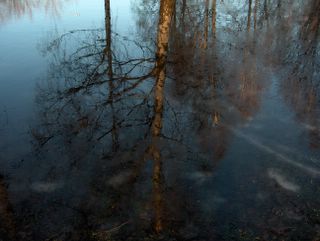
Tässä on lumien sulamisvesistä syntynyt vesilätäkkö kuvattuna samalla puistoalueella kuin edellisen kuvan lätäkkö, mutta seuraavana päivänä tilapäisesti selkeässä säässä. Siitä huolimatta pakkasta ei vielä ollut (Föhnilmiö vaikutti) ja niinpä syntyi vesiheijastumille otollinen hetki, kuten kuvasta nähdään. Koska maa oli useita senttejä jäässä ja veden haihtuminen oli vuodenajalle tyypillisesti heikkoa, niin näitä lätäköitä säilyi sateettomassakin tilanteessa pitkään heikosta sulamisvedensaannista huolimatta. Säätilanne: valitse 12.1.2006; Wetter3 A. Wetter3 B.
Here is a puddle of water formed of melting snow and it was pictured in the same park location as the puddle of the previous photo, but in the next day during temporarily clear weather. Despite of that it wasn't freezing yet (the Föhn phenomenon was affecting) and therefore the situation was suitable for water reflections as it is seen in the picture. Because the soil was frozen several centimetres deep and the evaporation of water was typically slow for the season, these puddles were remained long time even in a rainless condition despite the lack of melting water distripution. Weather condition: choose 12.1.2006; Wetter3 A. Wetter3 B.Helsingin Puistolan säätilasto tammikuussa 2006 - Weather chart of Puistola, Helsinki in January 2006.Flickr 1 Flickr 2 
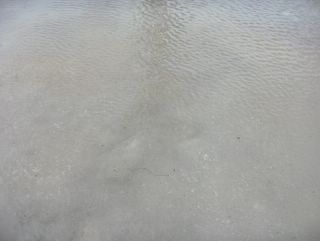
Tammikuun 10. päivänä alkanut suojasääjakso sulatti vesisateiden kera lumia pois melko nopeasti. Tässä kuvassa nähdään, kuinka nurmikon notkossa olevan jään päälle oli kerääntynyt lumien ja jään sulamisvettä. Ko. päivänä länsituuli oli voimakasta ja kuvan vesilätäkössä nähdään sen vaikutuksesta aaltoja, kun voimakas puuska sattui kohdalle. Lätäkön takana on koivu, jonka hahmo heijastui aalloista huolimatta hämärästi vedestä. Kuva on otettu Vantaan Tikkurilassa. Säätilanne: valitse 11.1.2006; Wetter3 A. Wetter3 B.
A mild thaw that started at 10th of January and rainy weather melted snow away in a rather fast rate. In this picture we see, how the melting water of the snow and ice had been gathered on the top of the icesurface, which was situated in the dell of a lawn. During this day westerly winds were strong and there are waves to be seen in the puddle because of that, when a powerfull gust reached the scene. There's a birch tree behind the puddle and the silhuet of that was reflected faintly from the water despite the waves. The photo is taken in the district of Tikkurila in Vantaa (near Helsinki). Weather condition: choose 11.1.2006; Wetter3 A. Wetter3 B.Helsingin Puistolan säätilasto tammikuussa 2006 - Weather chart of Puistola, Helsinki in January 2006.Flickr 1 Flickr 2 
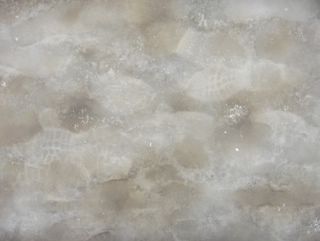
Tässä tilanteessa puistokäytävän notkoon oli kerääntynyt vettä, joka oli jäätynyt ja sulanut alkutalven mittaan useita kertoja. Samalla tähän päälle sataneisiin lumikerroksiin oli syntynyt jälkiä ihmisten liikkumisesta useissa eri vaiheissa. Tuloksena oli luonnon ja ihmisten yhteisvaikutuksella muodostunut jalanjälkitaideteos. Vuodenvaihteessa satanut lumi sulautui onneksi tähän pintaan eikä peittänyt sitä, koska vettä oli riittävästi jään pinnalla. Kuva on otettu Espoon Tapiolassa. Säätilanne: valitse 6.1.2006; Wetter3 A. Wetter3 B.
In this case there had been gathered water to the dell on the path in a park. The water had been frozen and melted back and forth for several occasions during the early winter. During the same time tracks made by people had been formed on the top of this surface on different occasions. As a result of that a work of art with footprints had been formed with the simultanious effect of both nature and humans. The snow that fell at the turn of the year fortunately fused into this surface and did not cover it, because there was enough water on the surface of the ice. The photo is taken in the district of Tapiola in Espoo. Weather condition: choose 6.1.2006; Wetter3 A. Wetter3 B.Helsingin Puistolan säätilasto tammikuussa 2006 - Weather chart of Puistola, Helsinki in January 2006.Flickr 1 Flickr 2 

Kuvassa on jäätä, jonka päällä oli ollut vettä ja sen sekaan oli satanut lunta. Tämä tapahtui vuoden vaihteen suojasään aikana, jolloin satoi vähän vettä ja lunta. Tuloksena oli karhea lumikuorrute, joka oli tässä vaiheessa jäätynyt kiinni alapuoliseen jäähän heikoissa pakkasissa. Vuodenvaihteen matalapaineiden ja etelä - lounaistuulien jälkeen nyt oli vallinnut jo useita päiviä lähes tyyni keskileveysasteiden korkeapaine heikkoine pakkasineen; lämpötilat olivat enimmäkseen 0 ja -5 asteen välillä. Kuva on otettu Espoon Tapiolassa. Säätilanne: valitse 6.1.2006; Wetter3 A. Wetter3 B.
In the picture there's ice, that had been covered with water and amongst it snow had been fallen. This happened during the mild thaw at the turn of the year, when it rained and snowed a little. As a result of that a crispy layer of snow was formed, which had been frozen at this stage into the ice beneath during a slightly frosty weather. After low pressures and south - southwesterly winds at the turn of the year now there had been prevailed a middle latitude high pressure with calm winds allready for several days along weak frosts; the temperatures were mostly between 0 C and -5 C. The photo is taken in the district of Tapiola in Espoo (near Helsinki). Weather condition: choose 6.1.2006; Wetter3 A. Wetter3 B.
Helsingin Puistolan säätilasto tammikuussa 2006 - Weather chart of Puistola, Helsinki in January 2006.Flickr 1 Flickr 2 

















